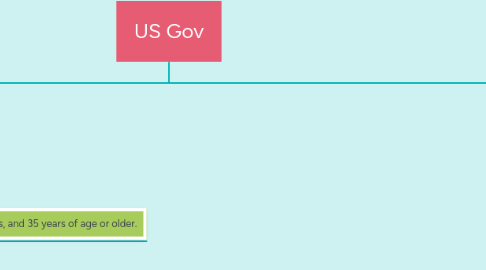
1. Legislative Branch
1.1. The two chambers of Congress
1.1.1. The United States Congress is the bicameral legislature of the federal government in the United States, and has of two chambers: the House of Representatives and the Senate.
1.1.2. Senate
1.1.2.1. age (at least thirty years of age); U.S. citizenship (at least nine years); and residency in the state a senator represents at time of election.
1.1.2.2. Length of term and how many terms
1.1.2.2.1. There are 2 terms but each are 6 years
1.1.3. House of Reps
1.1.3.1. be at least twenty-five years old; (2) have been a citizen of the United States for the past seven years; and (3) be (at the time of the election) an inhabitant of the state they represent.
1.1.3.2. Term length and how many
1.1.3.2.1. The House of Representatives serve two, year terms.
1.2. How many senators snare there
1.2.1. There are 100 senators, 2 in each state
1.3. How many people are in the House of Reps
1.3.1. There are 435 members in the house
1.4. Powers of this branch
1.4.1. the legislative branch makes all laws, declares war, regulates interstate and foreign commerce and controls taxing and spending policies.
1.4.2. Implied powers
1.4.2.1. These are laws that aren’t stated in the constitution
1.4.3. Elastic clause
1.4.3.1. United States Constitution that grants Congress the power to pass whatever laws are deemed “necessary and proper” to help Congress to carry out the enumerated powers
1.4.4. Expressed powers
1.4.4.1. Are laws in the constitution
2. Executive Branch
2.1. Qualifications to be President
2.1.1. natural born citizen of the United States, a resident for 14 years, and 35 years of age or older.
2.2. Term length and limit
2.2.1. 4 year long term, gets 2 terms
2.3. The power of the Executive Branch
2.3.1. It’s more like the President of the branches, being able to veto, or reject, a proposal for a law; appoint federal posts, such as members of government agencies; negotiate foreign treaties with other countries; appoint federal judges; and grant pardons, or forgiveness
2.4. Roles of the President
2.4.1. 1) chief of state, (2) chief executive, (3) chief administrator, (4) chief diplomat, (5) commander in chief, (6) chief legislator, (7) party chief, and (8) chief citizen.
2.5. Number of Executive Departments
2.5.1. 15 Departments
2.5.2. The Executive Department Names
2.5.2.1. the Secretaries of Agriculture, Commerce, Defense, Education, Energy, Health and Human Services, Homeland Security, Housing and Urban Development, Interior, Labor, State, Transportation, Treasury, and Veterans Affairs
3. Judicial Branch
3.1. Qualifications
3.1.1. There are no restrictions or rules to be a member of a Supreme Court
3.2. Picking
3.2.1. Picked by President approved b senate
3.3. How many justices
3.3.1. 9
3.4. Chief Justice is the title of the dead justice
3.5. They serve until they either retire or pass
3.6. Powers
3.6.1. Their railings cannot be appealed and they can pass bills into laws

